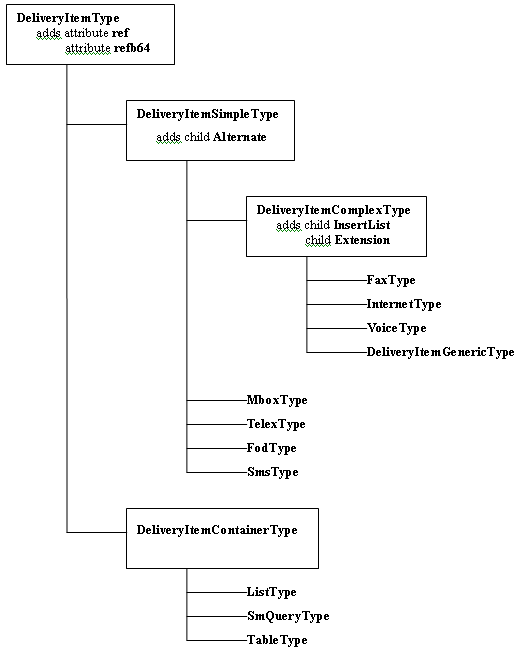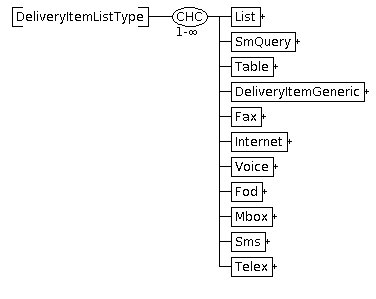 | Cloud Fax and Notifications API 2.4 Documentation Common Types and Elements | Cloud Fax and Notifications API Forums Home |
3.9 DeliveryItemListType
The schema representing the destination address for delivery of messages or reports is somewhat complex. The older schemas (2004/11 and 2007/02, which are still the current versions for some functions) used a hierarchy of types illustrated by this diagram:

More recent schemas flatten this hierarchy in order to reduce the number of classes some development tools generate based on the schema, but the ultimate XML representation of destinations is the same.
A catch-all type, DeliveryItemListType is defined that represents one or more elements of any of the 11 final types of destination, and is used in several places where a set of destinations is required. Note that DeliveryItemListType designates a set of destinations, not necessarily just one. Also note that DeliveryItemListType is a type, and therefore does not itself directly appear in an XML document - there would instead be one or more of the final destination types.

| Tag Name & type | Description | |
|---|---|---|
| DeliveryItemListType | Contains one or more child elements representing destination addresses. | |
| List ListType | A reference to a destination list previously stored on an EasyLink system. See ListType. | |
| SmQuery SmQueryType | A set of destinations derived from a previously established dataset. See SmQueryType. | |
| Table TableType | A set of destinations represented as a CSV file. See TableType. | |
| DeliveryItemGeneric DeliveryItemGenericType | A non-type-specific destination. Any type of destination can be represented in this generic element, although setting additional fields used by the various types (for example, coversheet fields for a fax destination) requires knowing the field names used directly by EasyLink systems. Some kinds of destinations (e.g. URL) can only be represented using a DeliveryItemGeneric element. See DeliveryItemGenericType. | |
| Fax FaxType | Fax destination data. See FaxType. | |
| Internet InternetType | Email destination data. See InternetType. | |
| Voice VoiceType | Voice destination data. See VoiceType. | |
| Fod FodType | A destination in the Fax-On-Demand repository in the EasyLink switch. See FodType. | |
| Mbox MboxType | A EasyLink mailbox destination. See MboxType. | |
| Sms SmsType | A text (SMS) message destination. See SmsType. | |
| Telex TelexType | A Telex destination. See TelexType. | |
There are some restrictions on destinations appearing in Alternate elements. The schemas make recursive use of the same destination type definitions, but due to the internal representation of destinations Alternates cannot contain InsertList elements or Extension elements that include segments other than the default segment.
It should be noted that the XML representation of destinations is not used by EasyLink systems internally. Since the XML supports, in most cases, a variety of ways to represent the data, a destination retrieved from the system may not match exactly the XML format that was originally supplied.
Each of the 11 final types is described in subsequent pages as they appear in their final form.
| © Copyright 2020 OpenText Corp. All Rights Reserved. Privacy Policy | Cookie Policy |
This information is subject to change. Please check frequently for updates. Modified October 06, 2020 |